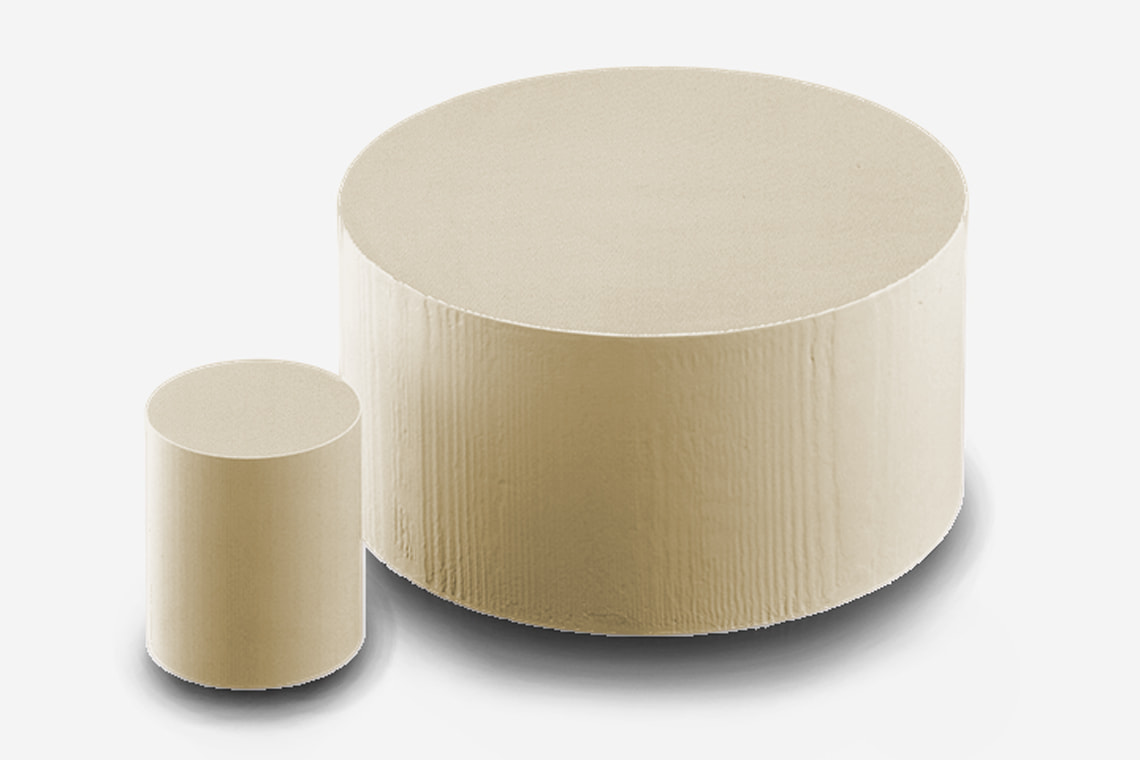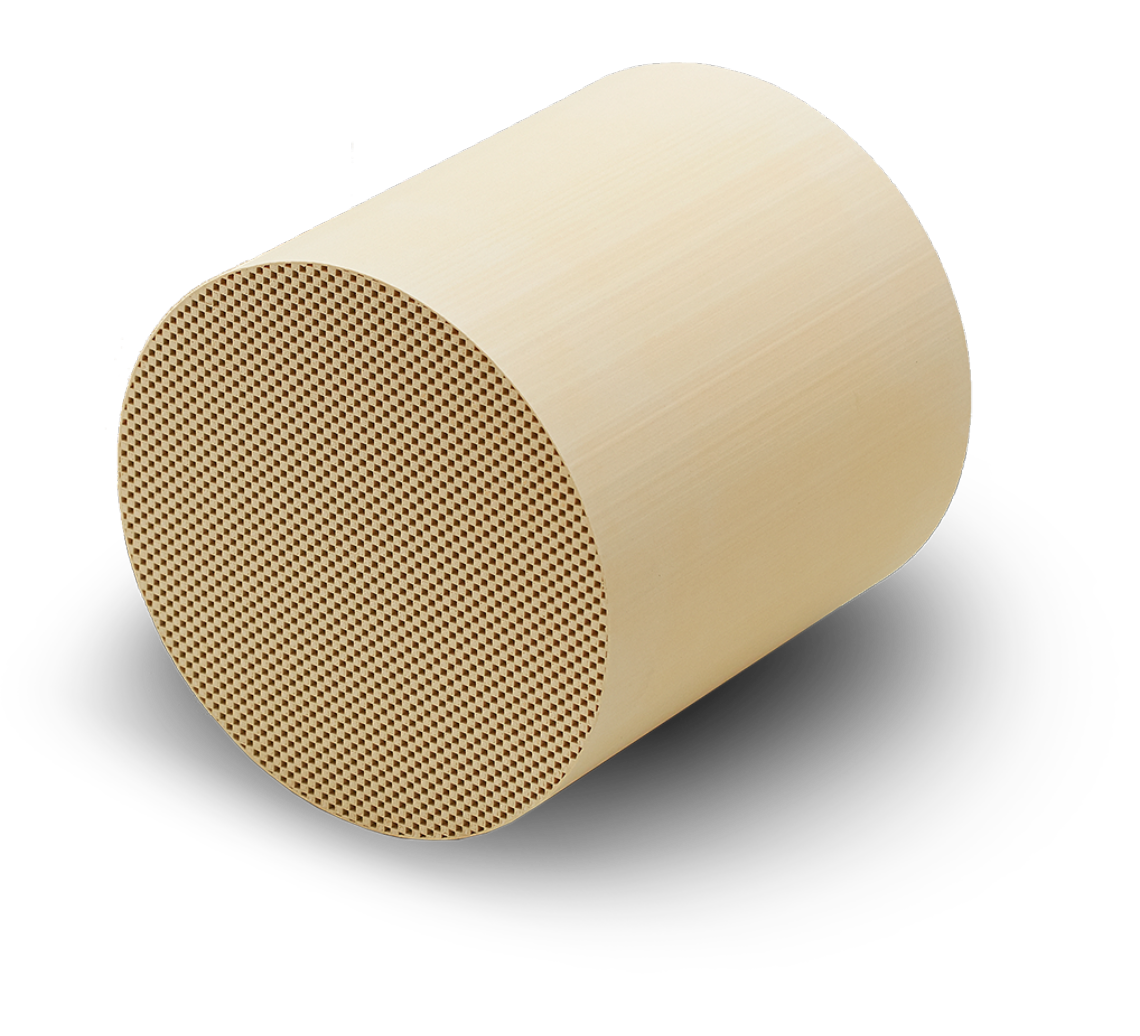Keeping the air clean using exhaust
purification technologies
Home | Business Fields | Automotive Ceramics
When it comes to ceramics, the NGK group has a vast insight in manufacturing these for more than 100 years. In the automotive sector NGK has led the production of ceramic substrates and filters since the mid 1970’s and the late 1980’s, respectively. For our customers we are bringing years of experience and knowledge in the field of exhaust gas aftertreatment systems. Furthermore, in 1996 NGK started production of ceramic sensor probes for NOx sensors which extended our portfolio of products that ensure clean air from combustion engines.
HONEYCERAM cordierite ceramic substrate was first developed in the 1970’s as a new type of catalyst support for the automotive and industrial catalytic converter markets. Its name stems from the array of parallel channels or cells that create the look of a honeycomb. The extensive benefits include high geometric surface area, durability and low pressure drop paired with a fast warm-up.
Our continuous substrate development ensures best performance for different catalyst types. Especially the wide range of substrate designs enables a perfect adaption for each application. With a choice of square or hexagonal cell configurations HONEYCERAM is used by car manufacturers worldwide.
Ceramic substrates made of cordierite have been used for the purification of automotive exhaust gas from internal combustion engines in passenger cars as well as in heavy-duty vehicles (as Large Size HONEYCERAM, LSH). In addition, also in the field of small engines like in motorcycles or in the field of agricultural machinery HONEYCERAM substrates are being used.


Modern gasoline powered engines with direct fuel injection are a key technology for fuel saving and CO2 reduction. However, they also emit more solid particulates containing soot. GPFs are ceramic cordierite filters that remove particulate matter (PM) from exhaust gases.
The advantage of GPFs produced by NGK is excellent gas permeability. Since blocking the flow of exhaust gases causes an increase in fuel consumption in a car, NGK is developing particulate filters in order to further improve the permeability parameter. Thin GPF walls have a higher porosity while ensuring filtration efficiency, i.e. capturing PM, and durability to avoid damage, despite exposure to high-temperature and high-pressure exhaust gases.
Thanks to the extrusion technology developed over many years and the material technology, which allows precise control over the dimensions of the pores and the way they are shaped, we have achieved an optimum performance in terms of filtration efficiency, pressure drop and ash capacity. NGK provides GPF technologies in a variety of porosities and cell structures specifically designed for catalysed or non-catalysed vehicle applications.
In cooperation with the key players in catalytic coating technology we produce filters with different catalytic activities, e.g. three way catalyst coating.
NGK develops high-performance diesel particulate filters for passenger cars and heavy commercial/heavy duty vehicles exhaust systems as well as for non-road applications and mobile machinery. To meet current and future emission limits NGK has developed particulate filters based on ceramic substrate technology for cleaning the particulate emissions of diesel engines. These particulate filters have demonstrated impressive characteristics not only in filtration efficiency but in thermal shock resistance and low pressure drop as well.
As one of the few manufacturers to mass-produce two kinds of diesel particulate filters, cordierite and silicon carbide, we use our ceramic technologies to support even cleaner diesel vehicle emissions.
Together with several coating suppliers we provide – in addition to the filtration function – filters with catalytic functionality to remove for example NOx emissions from the exhaust gas with a selective catalytic reduction (SCR) coating.

Cordierite particulate filter has more possibilities to apply with high porosity that can incorporate high amounts of washcoat with low pressure drop. On this basis catalysed filter systems possess a superb regeneration efficiency and favourable burn-off characteristics. This has been proven in large-scale practical applications. NGK has developed several types of cordierite diesel particulate filters for heavy commercial vehicles by adjusting mean pore size and porosity.
NGK’s expertise in processing ceramic substrates has been utilised to develop and refine the variation of pore structures. This means that NGK can accurately control the mean pore size and porosity of the material and therefore adjust the filter according to application requirements and thus improving performance for a catalysed DPF system as well. When compared to cordierite, Si-SiC benefits from higher heat capacity together with excellent thermal conductivity. These features result in an increase of thermal robustness and thus soot mass limit. Because of the silicon carbide DPFs greater thermal expansion, they are produced in segments that are assembled in an appropriate cement block instead of a mono-block.

Smart NOx Sensor
(SNS, joint development and production with Vitesco Technologies GmbH)
With 40 years of experience in aftertreatment system market, we are producing sensor probes for automotive NOx sensors since 1996. We are the experts in the field of functional ceramics and combined with the know-how of our development partner, Vitesco Technologies GmbH, we lead the global NOx sensor market with more than 100 Mio. sensors in the field as of 2021.
We, NGK Group and Vitesco Technologies GmbH are determined to continuously research and develop a range of better and more reliable next-generations NOx sensors with an eye on future automotive legislative targets.
We produce the sensor probe, a key-functioning part of NOx sensor, that is reliable, competitive, and designed based on cutting edge technologies for Global Automotive customers. Using zirconia (ZrO2) thick film technology, we have developed NOx sensors capable of measuring NOx concentration in exhaust gas with high accuracy in ppm level and long lifetime.
Key facts

